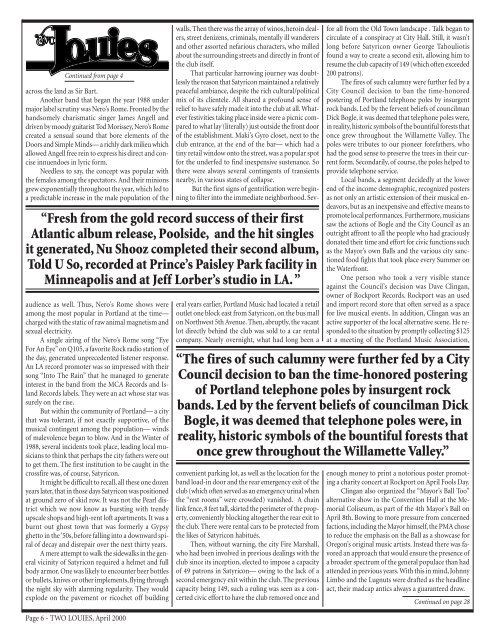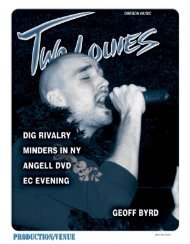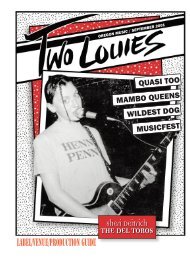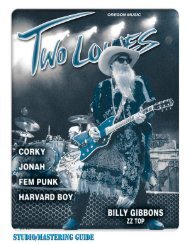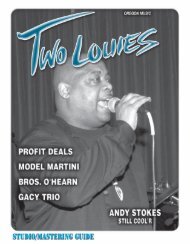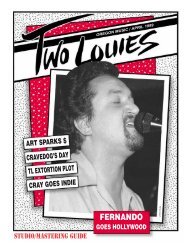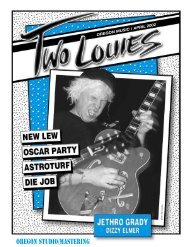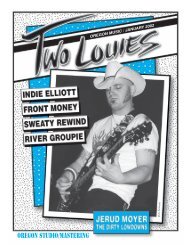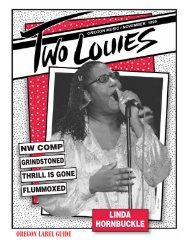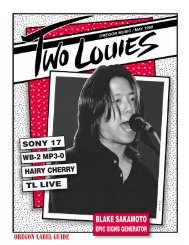2L April 00 Studio - Two Louies Magazine
2L April 00 Studio - Two Louies Magazine
2L April 00 Studio - Two Louies Magazine
You also want an ePaper? Increase the reach of your titles
YUMPU automatically turns print PDFs into web optimized ePapers that Google loves.
Continued from page 4<br />
across the land as Sir Bart.<br />
Another band that began the year 1988 under<br />
major label scrutiny was Nero’s Rome. Fronted by the<br />
handsomely charismatic singer James Angell and<br />
driven by moody guitarist Tod Morissey, Nero’s Rome<br />
created a sensual sound that bore elements of the<br />
Doors and Simple Minds— a richly dark milieu which<br />
allowed Angell free rein to express his direct and concise<br />
innuendoes in lyric form.<br />
Needless to say, the concept was popular with<br />
the females among the spectators. And their minions<br />
grew exponentially throughout the year, which led to<br />
a predictable increase in the male population of the<br />
audience as well. Thus, Nero’s Rome shows were<br />
among the most popular in Portland at the time—<br />
charged with the static of raw animal magnetism and<br />
sexual electricity.<br />
A single airing of the Nero’s Rome song “Eye<br />
For An Eye” on Q105, a favorite Rock radio station of<br />
the day, generated unprecedented listener response.<br />
An LA record promoter was so impressed with their<br />
song “Into The Rain” that he managed to generate<br />
interest in the band from the MCA Records and Island<br />
Records labels. They were an act whose star was<br />
surely on the rise.<br />
But within the community of Portland— a city<br />
that was tolerant, if not exactly supportive, of the<br />
musical contingent among the population— winds<br />
of malevolence began to blow. And in the Winter of<br />
1988, several incidents took place, leading local musicians<br />
to think that perhaps the city fathers were out<br />
to get them. The first institution to be caught in the<br />
crossfire was, of course, Satyricon.<br />
It might be difficult to recall, all these one dozen<br />
years later, that in those days Satyricon was positioned<br />
at ground zero of skid row. It was not the Pearl district<br />
which we now know as bursting with trendy<br />
upscale shops and high-rent loft apartments. It was a<br />
burnt out ghost town that was formerly a Gypsy<br />
ghetto in the ‘50s, before falling into a downward spiral<br />
of decay and disrepair over the next thirty years.<br />
A mere attempt to walk the sidewalks in the general<br />
vicinity of Satyricon required a helmet and full<br />
body armor. One was likely to encounter beer bottles<br />
or bullets, knives or other implements, flying through<br />
the night sky with alarming regularity. They would<br />
explode on the pavement or ricochet off building<br />
Page 6 - TWO LOUIES, <strong>April</strong> 2<strong>00</strong>0<br />
walls. Then there was the array of winos, heroin dealers,<br />
street denizens, criminals, mentally ill wanderers<br />
and other assorted nefarious characters, who milled<br />
about the surrounding streets and directly in front of<br />
the club itself.<br />
That particular harrowing journey was doubtlessly<br />
the reason that Satyricon maintained a relatively<br />
peaceful ambiance, despite the rich cultural/political<br />
mix of its clientele. All shared a profound sense of<br />
relief to have safely made it into the club at all. Whatever<br />
festivities taking place inside were a picnic compared<br />
to what lay (literally) just outside the front door<br />
of the establishment. Maki’s Gyro closet, next to the<br />
club entrance, at the end of the bar— which had a<br />
tiny retail window onto the street, was a popular spot<br />
for the underfed to find inexpensive sustenance. So<br />
there were always several contingents of transients<br />
nearby, in various states of collapse.<br />
But the first signs of gentrification were beginning<br />
to filter into the immediate neighborhood. Sev-<br />
“Fresh from the gold record success of their first<br />
Atlantic album release, Poolside, and the hit singles<br />
it generated, Nu Shooz completed their second album,<br />
Told U So, recorded at Prince’s Paisley Park facility in<br />
Minneapolis and at Jeff Lorber’s studio in LA. ”<br />
eral years earlier, Portland Music had located a retail<br />
outlet one block east from Satyricon, on the bus mall<br />
on Northwest 5th Avenue. Then, abruptly, the vacant<br />
lot directly behind the club was sold to a car rental<br />
company. Nearly overnight, what had long been a<br />
convenient parking lot, as well as the location for the<br />
band load-in door and the rear emergency exit of the<br />
club (which often served as an emergency urinal when<br />
the “rest rooms” were crowded) vanished. A chain<br />
link fence, 8 feet tall, skirted the perimeter of the property,<br />
conveniently blocking altogether the rear exit to<br />
the club. There were rental cars to be protected from<br />
the likes of Satyricon habitués.<br />
Then, without warning, the city Fire Marshall,<br />
who had been involved in previous dealings with the<br />
club since its inception, elected to impose a capacity<br />
of 49 patrons in Satyricon— owing to the lack of a<br />
second emergency exit within the club. The previous<br />
capacity being 149, such a ruling was seen as a concerted<br />
civic effort to have the club removed once and<br />
for all from the Old Town landscape . Talk began to<br />
circulate of a conspiracy at City Hall. Still, it wasn’t<br />
long before Satyricon owner George Tahouliotis<br />
found a way to create a second exit, allowing him to<br />
resume the club capacity of 149 (which often exceeded<br />
2<strong>00</strong> patrons).<br />
The fires of such calumny were further fed by a<br />
City Council decision to ban the time-honored<br />
postering of Portland telephone poles by insurgent<br />
rock bands. Led by the fervent beliefs of councilman<br />
Dick Bogle, it was deemed that telephone poles were,<br />
in reality, historic symbols of the bountiful forests that<br />
once grew throughout the Willamette Valley. The<br />
poles were tributes to our pioneer forefathers, who<br />
had the good sense to preserve the trees in their current<br />
form. Secondarily, of course, the poles helped to<br />
provide telephone service.<br />
Local bands, a segment decidedly at the lower<br />
end of the income demographic, recognized posters<br />
as not only an artistic extension of their musical endeavors,<br />
but as an inexpensive and effective means to<br />
promote local performances. Furthermore, musicians<br />
saw the actions of Bogle and the City Council as an<br />
outright affront to all the people who had graciously<br />
donated their time and effort for civic functions such<br />
as the Mayor’s own Balls and the various city sanctioned<br />
food fights that took place every Summer on<br />
the Waterfront.<br />
One person who took a very visible stance<br />
against the Council’s decision was Dave Clingan,<br />
owner of Rockport Records. Rockport was an used<br />
and import record store that often served as a space<br />
for live musical events. In addition, Clingan was an<br />
active supporter of the local alternative scene. He responded<br />
to the situation by promptly collecting $125<br />
at a meeting of the Portland Music Association,<br />
“The fires of such calumny were further fed by a City<br />
Council decision to ban the time-honored postering<br />
of Portland telephone poles by insurgent rock<br />
bands. Led by the fervent beliefs of councilman Dick<br />
Bogle, it was deemed that telephone poles were, in<br />
reality, historic symbols of the bountiful forests that<br />
once grew throughout the Willamette Valley.”<br />
enough money to print a notorious poster promoting<br />
a charity concert at Rockport on <strong>April</strong> Fools Day.<br />
Clingan also organized the “Mayor’s Ball Too”<br />
alternative show in the Convention Hall at the Memorial<br />
Coliseum, as part of the 4th Mayor’s Ball on<br />
<strong>April</strong> 8th. Bowing to more pressure from concerned<br />
factions, including the Mayor himself, the PMA chose<br />
to reduce the emphasis on the Ball as a showcase for<br />
Oregon’s original music artists. Instead there was favored<br />
an approach that would ensure the presence of<br />
a broader spectrum of the general populace than had<br />
attended in previous years. With this in mind, Johnny<br />
Limbo and the Lugnuts were drafted as the headline<br />
act, their madcap antics always a guaranteed draw.<br />
Continued on page 28


